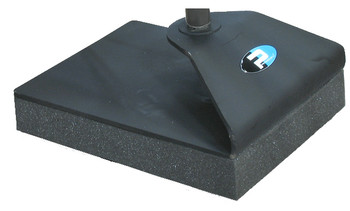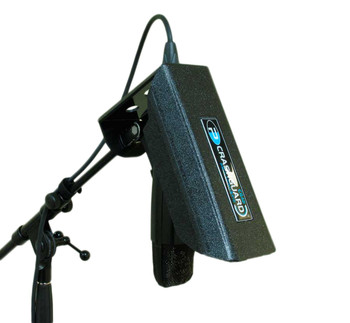Description
The TriPad (set of three) is a tripod microphone stand isolator designed to reduce disruptive resonance and noise from the studio floor, stage or drum riser from entering the microphone and contaminating the recording.
When recording, capturing the true essence of the instrument is achieved by placing the microphone far enough away so that the instrument as a whole along with the direct sound field will be take in. As you move the mic away from the source, the sensitivity of the microphone is increased and background noise invariably gains prominence.
Noise, like sound is a vibration. Common sources are street traffic, foot steps, heat and air conditioning systems, and other instruments. These are transmitted through the air and by vibrating through solids such as the floor and a microphone stand. The TriPad eliminates floor-borne vibrations by introducing a ‘spring-like’ isolation pad that essentially floats the microphone stand and decouples it from the floor.
The design is undeniably simple, yet incredibly effective. It begins with high density open-cell acoustic foam that has been modified for greater firmness to better stabilize the mic stand. It is then cut into a simple disc shape, drilled at a precise angle to match the industry standard K&M 201 tripod stand and then cut again to provide an access slot for quick mounting. Once in place the TriPad stays attached onto the mic stand making it easy to pick up and relocate. The benefits are immediately obvious: you get more of the instrument less background noise. This in turn means you can achieve desirable results without having to introduce radical equalization curves as a means to correct embedded problems.
The Primacoustic TriPad is a modestly priced yet highly effective tripod mic stand isolator that will quietly go about improving the sound of your recording every day! Comes shipped in a set of three units in a handy storage tube.
Features
- Isolates the microphone stand from studio floor
- Eliminates disruptive resonance from entering the mic
- Cleans up signal for less noise when recording
- Improves clarity to deliver more natural sound
The Science Of The TriPad
The science behind the TriPad is based on eliminating vibrations. You are sitting at your desk, a truck goes by. You hear the roar of the engine through the walls and feel the vibrations even though the cause can be 30 meters (100 feet) away. Sound is vibration. It travels in waves through gases like air, liquids like water, and through solids such as your office walls, car windows, studio floor and the earth beneath. To stop sound, you have to stop the vibration.
The TriPad is a simple isolation pad that mounts on a tripod microphone stand to isolate it from floor-borne noise. It works by floating the mic stand so that vibrations are decoupled. Because the floor, TriPad acoustical foam and the mic stand all have a different mass, this virtually eliminates their coupling sympathetically through the air. Once installed, noise that would normally travel through the floor into the mic stand is essentially dissipated in the foam isolator by thermo-dynamic transfer or simply put, vibration and heat.
Vibrations in the studio
When recording a voice or instrument in the studio, it is usually preferable to move the microphone away from the source so that the whole instrument is captured. For instance, the sound of an acoustic guitar comes from the sound hole, the spruce top, the pick on the strings and the combination of all of these as they combine in the nearby acoustic space. Placing the mic near the hole may be required on a live stage where the guitar is competing with other instruments and audience noise. In the studio, we have the luxury of moving the mic around until it sounds right. But as you move the microphone away from the guitar, you must increase the microphone’s sensitivity by increasing the gain. Not only does the microphone amplifier introduce noise, but other noises that may be masked when close mic’ing all of a sudden become apparent. This can be referred to as signal-to-noise. The further you are from the source, the lower the signal, and louder the noise.
Common noise problems include street noise from cars and trucks passing by; air conditioning or heating systems kicking in; foot stomping by the talent while they sign or play; paper sheets brushing as the musical score is turned to the next page; drums and bass vibrating through the floor… there is no end. This is precisely why top-end studios ‘float their floors’… to stop vibration borne noise.
Eliminating resonant frequencies
Up until now, we have been discussing noise. But noise does not just come in the form of background noise; it can also appear as a disruptive frequency known as resonance. For instance… when recording electric guitar, the sound from the speaker is generally captured using a nearby microphone. When the amp is playing, the speaker is moving back and forth which invariably will couple through the floor, the mic stand and into the microphone. As sound travels through these mediums, each will resonate at different frequencies. When these combine with the sound emanating from the loudspeaker, they will interact by either amplifying or canceling each other out depending on their phase and amplitude. This can ultimately cause a comb-filtering effect. Isolating the microphone stand helps eliminate the peaks and valleys for a more natural sound.
Managing resonance in a live sound environment
Studios are not alone in having to deal with noise and resonance. Live stages and orchestra pits also experience the same problems. In fact, stage resonance is a common problem that comes in many forms: Low frequency vibrations from the PA system will travel through the stage floor, through the mic stand and into the microphone competing with the desired sounds. Drum risers are usually hollow which means that they will have a resonant frequency of their own. The bass tones from the kick drum and bass guitar will cause the riser to vibrate, which in turn will resonate into the stand and drum mics. With bass guitar, the hollow stage can compete with the bass amplifier to create modes that can either cancel or amplify each other, causing strange peaks and valleys further disrupting the sound. The TriPad minimizes the problem by decoupling the microphone stand from the floor or stage and attenuating the problem resonant frequency from entering the mic.
| Application | Problem | Solution |
|---|---|---|
| Studio Vocal Mic | Gain increased to capture nuances and deep low frequencies for warmth. | Usually mounted on a mic stand with a form of suspension. Not always sufficient. TriPad ads extra measure of isolation. |
| Studio Instrument Mic | Mic moved away from source to capture sound of instrument in the room. Sensitivity of mic increased, noise enters. | TriPad eliminates floor borne noise from transmitting through mic stand. |
| Drum Kit Overhead Mics | Stereo set of mics placed above drum kit captures vibrations from kick drum through the drum riser. | Eliminate resonance by adding TriPads to the overhead mic stands. |
| Electric Guitar & Bass Mics | Sound from amp resonates through the floor coupling with mic stand, causes comb filtering. | Isolating the mic stand reduces peaks and valleys from combining with instrument amp. |
Specifications
Material: High density open cell acoustic foam
Dimensions: Width x Height 4” x 2.25”; 102mm x 57mm
Center Bore: 1" (24mm) - fits standard tripod mic stands legs
Color: Charcoal
Package: Set of three














